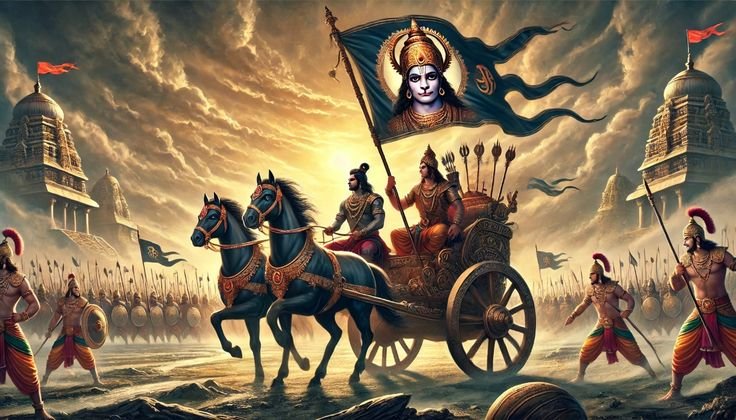Mahabharata
Ithihas Of Mahabharata

The Mahabharata is one of the most sacred and monumental epics in the Ithihas (divine history) of ancient India, composed by Sage Vyasa, who is also revered as Ved Vyasa—the compiler of the Vedas and Puranas. It is not merely a tale of kings and war but a profound spiritual, moral, and philosophical scripture that reflects the essence of human life and the eternal struggle between righteousness (dharma) and unrighteousness (adharma). Written in Sanskrit, the Mahabharata is the world’s longest epic, consisting of about 100,000 shlokas divided into 18 Parvas (books) and includes the divine scripture Bhagavad Gita, which stands as the heart of its wisdom.
The Ithihas of the Mahabharata begins with the royal lineage of the Kuru dynasty, based in the ancient kingdom of Hastinapura. The story revolves around the rivalry between the Pandavas and the Kauravas, two branches of the same royal family. The five Pandava brothers—Yudhishthira, Bhima, Arjuna, Nakula, and Sahadeva—were born to King Pandu, while the hundred Kauravas were the sons of his blind elder brother Dhritarashtra. Their growing enmity, fuelled by jealousy, pride, and the thirst for power, set the stage for the greatest war in history—the Kurukshetra War.
In the epic’s narrative, the Pandavas, despite being rightful heirs, were deceived in a rigged game of dice by Duryodhana and his uncle Shakuni. As a result, they were exiled for thirteen years, enduring hardship but remaining faithful to truth and virtue. After completing their exile, they sought peace and the return of their kingdom, but Duryodhana’s arrogance led to inevitable war. On the battlefield of Kurukshetra, the two sides stood ready to fight, and it was here that Lord Krishna, serving as Arjuna’s charioteer, delivered the timeless wisdom of the Bhagavad Gita. This divine discourse revealed the eternal truths of existence—duty, detachment, devotion, and the immortality of the soul.
The Mahabharata is not just a record of battles but a reflection of the human condition. It portrays the complexities of relationships, morality, and destiny. Each character represents different aspects of human nature—Yudhishthira embodies righteousness, Bhima symbolizes strength and passion, Arjuna reflects valor and doubt, Draupadi represents dignity and endurance, while Lord Krishna stands as the eternal guide of divine wisdom. Even the so-called antagonists, such as Duryodhana and Karna, are depicted with depth, showing that good and evil coexist within the human heart.
As the war concludes, nearly all warriors are destroyed, leaving behind a haunting silence that speaks of the futility of greed and the cost of pride. Yudhishthira, burdened by sorrow, finally understands the impermanence of worldly glory. In the end, the Pandavas renounce their kingdom and journey toward the Himalayas in search of liberation, symbolizing the soul’s path toward divine union.
The Mahabharata stands as an eternal Ithihas—not mythology but divine truth passed through generations. It teaches that life itself is a battlefield where every individual must uphold dharma despite trials and temptations. It reveals that the true victory is not over others, but over one’s own ignorance, ego, and desires. The message of the Mahabharata continues to echo through time—“Yato dharmastato jayah”—where there is righteousness, there is victory.





















































